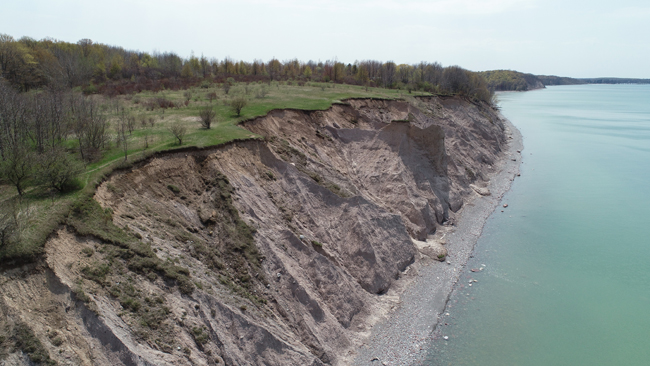
Bluff erosion along New York’s Great Lakes shoreline. Credit: Roy Widrig/NYSG
Contacts:
Kathleen Fallon, NYSG Coastal Processes & Hazards Specialist, E: kmf228@cornell.edu, P: (631) 632-8730
Roy Widrig, Great Lakes Coastal Processes and Hazards Specialist, E: rlw294@cornell.edu, P: (315) 312-3042
NYSG works with research partners to ensure information about coastal bluff erosion and recession is reaching stakeholders most impacted by these processes
Oswego and Stony Brook, NY, March 23, 2023 - Bluffs are steep cliffs or banks that can range in height from 10 feet to upwards of 50 feet. They are composed of loosely compacted sediments ranging in size from clays, silts, sand, and gravel to large boulders and bedrock. A significant population of New York’s residents live atop coastal bluffs along the shorelines of the Great Lakes and Long Island. Due to their steep nature, and the influence of waves, water level, seepage, and runoff, bluffs are susceptible to erosion and episodic failure that may result in large quantities of sudden movement of bluff material. This erosion is resulting in a nearly permanent recession of the shoreline in impacted locations.
New York Sea Grant (NYSG) collaborates with academic institutions, state and federal agencies, and local community groups to inform stakeholders about the current state of the science of coastal bluff erosion and recession.
In November 2022, NYSG invited stakeholders to participate in a two-hour, statewide Coastal Bluff Symposium to discuss the status of recent coastal bluff research. Stony Brook University, The Nature Conservancy, New York State Department of Environmental Conservation, and U.S. Army Corps of Engineers provided attendees with updates on research projects currently underway along both the Long Island and Great Lakes bluff shorelines. Sixty-one participants included representatives of state and federal agencies, academic institutions, non-governmental organizations, municipalities, environmental consultants, and shoreline residents. This educational opportunity was built on a NYSG-sponsored coastal erosion workshop held in 2020.
Additionally in 2022, NYSG completed an “Erosion and Recession of New York’s Coastal Bluffs” outreach document that discusses bluff formation, erosion processes acting on coastal bluffs, mass movements of bluffs, how to protect bluffs, and how to monitor and report bluff erosion. An insert is included to assist shoreline homeowners keep records to assess their properties to avoid potential bluff erosion-related issues. This educational resource has been distributed to stakeholders along the Great Lakes and Long Island shorelines and is available online.
NYSG is continuing its work with relevant partners to ensure information about coastal bluff erosion and recession is reaching stakeholders most impacted by these processes.
Partners:
• Stony Brook University
• The Nature Conservancy
• New York State Department of Environmental Conservation
• U.S. Army Corps of Engineers
More Info: New York Sea Grant
New York Sea Grant (NYSG), a cooperative program of Cornell University
and the State University of New York (SUNY), is one of 34 university-based
programs under the National Oceanic and Atmospheric Administration’s
National Sea Grant College Program.
Since 1971, NYSG has represented a statewide network of integrated
research, education and extension services promoting coastal community
economic vitality, environmental sustainability and citizen awareness
and understanding about the State’s marine and Great Lakes resources.
Through NYSG’s efforts, the combined talents of university scientists
and extension specialists help develop and transfer science-based
information to many coastal user groups—businesses and industries,
federal, state and local government decision-makers and agency managers,
educators, the media and the interested public.
The program maintains Great Lakes offices at Cornell University, SUNY
Buffalo, SUNY Oswego and the Wayne County Cooperative Extension office
in Newark. In the State's marine waters, NYSG has offices at Stony Brook
University in Long Island, Brooklyn College and Cornell Cooperative
Extension in NYC and Kingston in the Hudson Valley.
For updates on Sea Grant activities: www.nyseagrant.org has RSS, Facebook, Twitter, Instagram, and YouTube links. NYSG offers a free e-list sign up via www.nyseagrant.org/nycoastlines for its flagship publication, NY Coastlines/Currents, which is published quarterly.